![]()
![]()
![]()
Use LEFT and RIGHT arrow keys to navigate between flashcards;
Use UP and DOWN arrow keys to flip the card;
H to show hint;
A reads text to speech;
44 Cards in this Set
- Front
- Back
- 3rd side (hint)
|
Convert 1.35x10^5 inch/sec to velocity in mm/sec
|
- 3.429x10^5
|
1inch=25.4mm
|
|
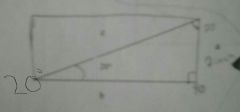
Calculate (C) when (A) = 2.0 inches
|
- 5.84
|
|
|
|
Calculate 34.5÷0.045×sin(45)
|
-542
|
|
|
|
Temperature changes ultrasonic velocity? T or F
|
- True
|
|
|
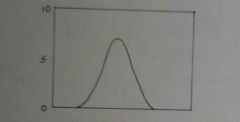
Calculate full screen height
|
- 70%
|
|
|
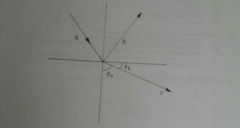
Name the reflected wave in the figure above
|
- B
|
|
|
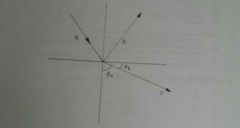
Name the refracted angle in the figure above
|
- -o- a
|
|
|
|
Calculate the refracted angle
sin -0-1 = 35 degrees V1plexiglass = 1.09×10^5 V2steel = 1.25×10^5 |
- 41 degrees
|
Use Snells Law
|
|
|
An ultrasonic transducer consists of...
|
- Piezoeletric Crystal
|
|
|
|
When measuring thickness at high temperatures...
|
- Calibration should be done at a temp as close as possible to the temperature of the component being inspected.
|
|
|
|
What is the correct formula for the near-field
|
D^2÷4×Wavelength
|
|
|
|
Which transducer has a bigger beam divergence?
|
2.25mhz, 0.375diameter
|
|
|
|
The focal length of a transducer can be...
|
smaller than the near-field
|
|
|
|
If the velocity of a longitudinal wave is 6×10^5 inch/sec, the velocity of a shear wave is..
|
- 3.5×10^5 inch/sec
|
|
|
|
The preferred wave for thickness measurements is..
|
- L-wave
|
|
|
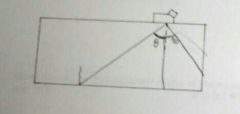
The preferred angle for angle beam is testing for the crack shown above
|
- 60
|
|
|
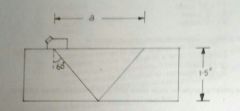
Calculate "A"
|
- 5.2
|
|
|
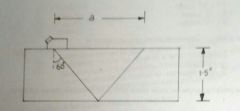
The middle path for the full "V" is...
|
- 6 inches
|
|
|
|
The ultrasonic velocity in the material can be varied by changing...
|
nothing
|
|
|
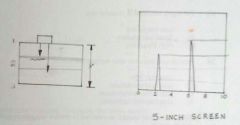
What is the flaw is the depth above?
|
- 1.0 inch
|
|
|

What should be the refracted angle of the transducer to detect crack "a" and "b" above?
|
- 30 degrees
|
|
|
|
Which material has higher ultrasonic attenuation?
|
- Rubber
|
|
|
|
For highly attenuative material use...
|
- Low frequency
|
|
|
|
How do you increase near surface resolution?
|
- Dual transducer
|
|
|
|
What transducer should be selected to resolve two closely spaced flaws in a carbon steel?
|
- High damped 5.0 mhz transducer
|
|
|
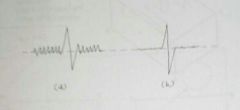
Which has a higher signal to noise ratio above?
|
- B
|
|
|
|
Transducer diameter increases, the beam spread...
|
- Decrease
|
|
|
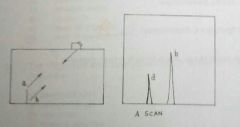
The crack sizing method shown in this figure is called...
|
- Tip diffraction
|
|
|
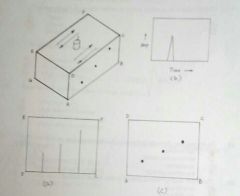
Which figure is a C scan?
|
- (A)
|
|
|

Which figure is an A-scan display?
|
- (B)
|
|
|
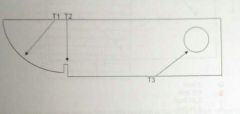
The angle beam on T1 is used to determine?
|
- Exit point
|
|
|
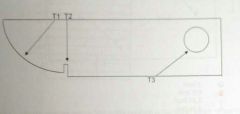
The straight beam on T2 is used to determine?
|
- Resolution
|
|
|
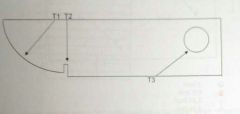
The angle beam on T3 is used to determine?
|
- Refracted angle
|
|
|
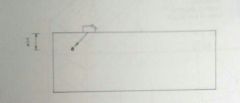
The block shown above has to be used to obtain a DAC curve for angle beam exam. What is the depth if the thickness is 2 inches?
|
- .5 inches
|
|
|

Which straight beam transducer location is best for detection of the crack in the component?
|
- (C)
|
|
|
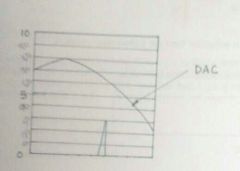
The indication shown above is...
|
- 50% DAC
|
|
|
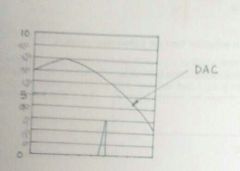
In the problem above how many decibels is the signal below reference?
|
- 6 DB
|
|
|

Which reflector will produce a bigger signal?
|
- (A)
|
|
|
|
A 5MHZ transducer that produces shear wave in steel will always have a wave length of ____ inches?
|
- 0.025"
|
|
|

Will there be a reflection from the Babitt/Steel interface?
|
- Yes
|
|
|
|
The amplitude of two signals A and B is 2.4 volts and 1.2 volts respectively. What is the ratio of signal A to signal B in dB?
|
- 6dB
|
|
|
|
The ratio of two signals is 14 dB. What is their ratio in percentage?
|
- 5:1
|
|
|
|
If you were inspecting a weld with a thickness of 1 inch using a 45 degree transducer and an indication was detected at a middle path of 2.1 inches, what would be the depth of the indication?
|
- 0.5 inches
|
|
|
|
When inspecting a weld with the shear wave method a sharp indication is detected and plotted off the centerline of the weld at the bottom surface of the part. The plots from either side of the weld, lack less than, 1/16th of an inch from touching. What do you think it is?
|
- inadequate penetration
|
|

